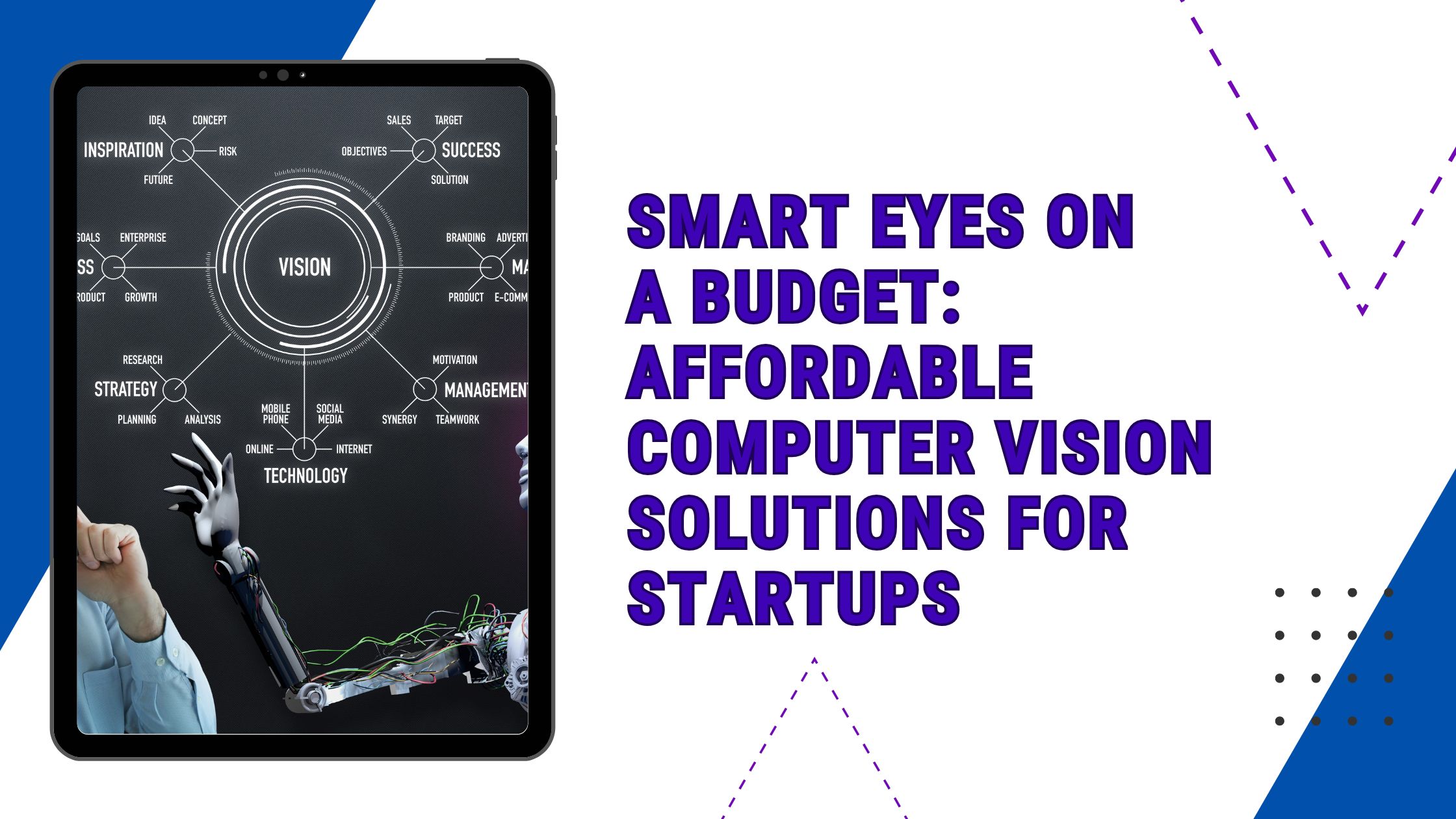“Smart Eyes on a Budget: Affordable Computer Vision Solutions for Startups”
In today’s rapidly evolving tech landscape, computer vision stands out as a game changer. For startups looking to carve their niche, harnessing the power of computer vision can unlock new opportunities and enhance user experiences. Imagine software that can analyze images, recognize faces, or even interpret videos in real-time—all on a budget! With advancements making these technologies more accessible than ever before, startups need not feel daunted by hefty price tags. Instead, affordable solutions are at their fingertips. Let’s dive into how your startup can leverage cost-effective computer vision solutions without compromising quality or innovation.
Why Startups Should Care About Computer Vision
Implementing computer vision can significantly enhance efficiency in startups. By automating tasks like image recognition and analysis, teams can save valuable time. This allows employees to focus on higher-level strategic initiatives.
Moreover, computer vision provides valuable insights through data interpretation. Startups can leverage these analytics for improved decision-making and innovative product development.
Cost savings are another major advantage. Automated processes reduce the need for extensive manual labor, leading to lower operational costs over time.
Customer experience also benefits immensely from this technology. With features such as personalized recommendations or enhanced security measures, startups can create a more engaging user environment.
Embracing computer vision positions startups as innovators in their fields. This not only attracts potential investors but also enhances brand credibility among consumers seeking cutting-edge solutions.
Common Challenges Faced by Startups in Implementing Computer Vision
Implementing computer vision can be daunting for startups. Limited budgets often restrict access to advanced technology and talent. This financial barrier can lead to compromises in quality.
Another significant challenge is the lack of expertise within small teams. Startups may struggle to find skilled professionals who understand complex machine learning algorithms essential for effective computer vision applications.
Data availability also poses a hurdle. High-quality, labeled datasets are crucial for training models, yet many startups lack resources to gather or purchase them.
Integration with existing systems creates additional complexity. Many startups face difficulties ensuring that new computer vision solutions work seamlessly with current processes or platforms.
Navigating regulatory compliance around data privacy and usage adds another layer of concern. Startups must ensure they adhere to legal standards while innovating in this rapidly evolving field.
Affordable Computer Vision Solutions for Startups
For startups eager to dive into computer vision, cost-effective solutions are key. Open-source software is a game changer. Platforms like OpenCV and TensorFlow provide powerful tools without the hefty price tag. These resources offer extensive libraries and active communities for support.
Low-cost hardware options also help keep expenses down. Raspberry Pi or Nvidia Jetson Nano boards can run sophisticated algorithms without breaking the bank. They’re perfect for prototyping and testing new ideas quickly.
Cloud-based services are another affordable route. Providers like Google Cloud Vision and Amazon Rekognition allow you to harness advanced capabilities on a pay-as-you-go basis, minimizing upfront investments while scaling as needed.
These avenues empower startups with innovative technology that was once only accessible to larger companies, leveling the playing field in an ever-evolving tech landscape.
A. Open-Source Software
Open-source software is a game-changer for startups venturing into computer vision. It provides access to powerful tools without the hefty price tag.
Platforms like OpenCV and TensorFlow offer robust frameworks for image processing and machine learning. These resources come with active communities, ensuring support and continuous updates.
Startups can customize open-source solutions to fit their unique needs, enhancing flexibility in development. Whether you’re building an object recognition system or automating visual inspections, these tools can be tailored accordingly.
Moreover, leveraging open-source software fosters innovation within your team. Developers can experiment freely without worrying about licensing fees or restrictions.
This accessibility empowers startups to iterate quickly, test ideas effectively, and ultimately deliver better products to market faster. Embracing open-source options opens up possibilities while keeping expenses in check.
B. Low-Cost Hardware Options
When it comes to implementing computer vision, hardware doesn’t have to break the bank. There are several low-cost options available that can help startups get started without a hefty investment.
Raspberry Pi is one such solution. This tiny, affordable computer can be paired with cameras and sensors to create powerful vision applications. Its versatility makes it ideal for experimenting with various projects.
Another option is the NVIDIA Jetson Nano. It offers more processing power while still being budget-friendly. Designed specifically for AI tasks, this board enables real-time image processing and machine learning capabilities right out of the box.
For those looking into DIY solutions, consider using webcams or even smartphones as initial hardware sources. These devices can perform surprisingly well in basic computer vision tasks before scaling up your setup later on.
These accessible tools allow startups to innovate without overwhelming financial pressure.
C. Cloud-Based Services
Cloud-based services have revolutionized access to computer vision technologies for startups. They provide powerful tools without the hefty price tag of on-premise solutions.
With cloud platforms, businesses can leverage advanced algorithms and machine learning models hosted remotely. This means you don’t need extensive hardware or specialized knowledge to get started. You can simply tap into existing infrastructure.
Many providers offer pay-as-you-go pricing models. This allows startups to scale their usage according to demand, optimizing costs as they grow. Plus, updates and maintenance are handled by the service provider, freeing up your team’s time for more strategic tasks.
Popular options such as Google Cloud Vision and Amazon Rekognition make implementation straightforward. They come with comprehensive documentation and support communities that help new users navigate challenges effectively.
In a fast-paced startup environment, these services enable rapid prototyping and experimentation—key elements in developing innovative products.
Tips for Choosing the Right Computer Vision Solution for Your Startup
When choosing a computer vision solution for your startup, start by defining your specific needs. Identify the problems you want to solve; this clarity will guide your search.
Next, evaluate scalability. Your chosen solution should grow alongside your business. Look for options that support increased data processing and functionality as demands change.
Consider integration capabilities too. Will it seamlessly connect with existing systems? A smooth integration process can save time and resources.
Don’t overlook user-friendliness either. An intuitive interface reduces training time and boosts productivity across teams.
Assess the community around open-source solutions or customer support from paid services. Strong support networks can be invaluable during implementation and troubleshooting phases.
Conclusion:
As startups strive to differentiate themselves in a competitive landscape, the adoption of computer vision can be a game-changer. Affordable solutions are available that allow even small businesses to leverage this technology without breaking the bank.
By exploring open-source software, low-cost hardware options, and cloud-based services, startups can find ways to implement effective computer vision strategies tailored to their unique needs.
Choosing the right solution involves careful consideration of your specific goals and resources. With thoughtful planning and execution, startups can harness the power of computer vision to enhance productivity, drive innovation, and ultimately secure their place in the market.
Investing in these technologies may seem daunting at first; however, with accessible tools and strategic insights on hand, any startup can embark on this journey toward smarter operations. Embracing affordable computer vision solutions is not just an option—it’s a smart strategy for growth in today’s digital world.




